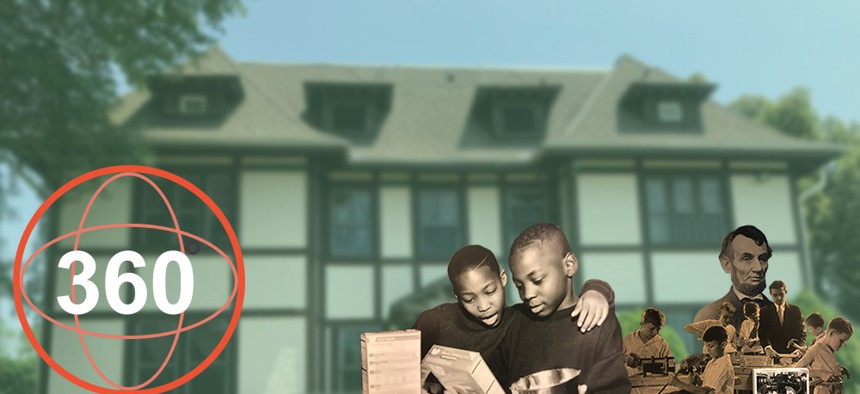360° video: What does a Close to Home facility look like?
This five-year-old initiative places youth in facilities close to their local communities rather than upstate facilities.

The Children's Village in Dobbs Ferry, N.Y. Photos by Zach Williams and The Children's Village; illustration by Zach Williams
This 360-video shows you inside The Children's Village facility in Dobbs Ferry.
It moves through three scenes (two out of three of them are multiple rooms "stitched" together) like a regular video but you can toggle around using your mouse or the "a" key (left) "w" key (up) "s" key (down) and "d" key (right). You can also use Google Cardboard and other headsets to watch the video in proper virtual reality. Use the YouTube app if you are trying to view on mobile.
The following is a transcript of the video:
For more than 100 years, New York City children have come to The Children’s Village, which houses a non-secure detention facility in Dobbs Ferry, about a half-hour north of the city.
This 180-acre facility in Westchester County is run by The Children’s Village, one of about a dozen Close to Home providers. The 5-year-old juvenile justice initiative places adjudicated youth in facilities close to their local communities rather than in upstate facilities. About 100 youth live in two-story cottages on this wooded campus after committing offenses such as assault theft and truancy.
“We have always served kids that are poor and kids that are vilified by community, that are seen as either incapable of assimilation or as not as important or as valued.”
The belief that rehabilitation rather than punishment is the best way to deal with these juveniles has always been deeply held here, but it’s also becoming official state policy with Raise the Age legislation, which will move teens under 18 out of the adult prison system starting in October 2018.
"We want to create an environment that reflects a home and a family, knowing full well that we are neither a home, nor a family.” - Jeremy Kohomban, president and CEO of The Children's Village.
One of those cottages is just ahead of you across the road. Behind you just beyond the right field line is where they go to school alongside a recreation center with a heated swimming pool, gym and even a cafe where some of them get part-time work.
The goal is to foster an environment that’s an attractive contrast to what these teens have experienced before, says Jeremy Kohomban, president and CEO of The Children’s Village.
“This campus is not a destination. It’s not a home. It’s not a family. It’s more like an emergency room than anything else … Being a teenager or being an older teen is not easy when you’re dealing with issues of race, poverty, disenfranchisement – and it’s very easy for these emotions to take over sometimes.”
A spirit of collaboration is what gets a teen ahead in this program. Good behavior and maturity can earn a placement in a coveted single room like the one you see. Trustworthiness can also be rewarded in more subtle ways, like allowing a teen to participate in weekly house cooking nights that help them develop their relationships with staff members while also teaching them some job skills.
“What we often say here is that one appropriate adult relationship is a game changer. In fact I have one young man now who works at a restaurant down the hill of this campus and he once told me that his first experience of being told he was good at something happened because a staff member took the time to teach him how to cook and then came back and said ‘You’re really good at this.’”
Democratic decision-making also pushes the teens to take on more responsibility. Is sleeping in on the weekend the prudent thing to choose – especially in the summer?
“It could be unless we have a trip planned. And all of you want to go to a waterpark and we want to get there before two o’clock in the afternoon so that we can have a few hours at the park. That’s a good opportunity for a negotiated decision to say what’s more important.”
But sometimes things can go wrong ...
To keep the kids out of trouble there’s a rigid daily routine for the dozen or so teenage boys who live inside a cottage like this. Little is left to chance – down to the details shown in this video. The chairs are heavy to prevent them from being thrown. Inspirational quotes adorn the walls like you'll see in both the bedroom and the hallway. Staff members keep watch at night at stations in the hallway and the teens only get to go where the staff allows them throughout the day.
Even when things go wrong, the focus has to be on making the teen figure out the consequences of their decision making, according to Kohomban.
“It’s a way of communicating. We spend a lot of time trying to figure out: ‘What was that all about?’ How did you go from having breakfast and then walking upstairs and getting into a fight?’”
Order must be maintained he says, but too much emphasis on control could result in The Children’s Village [formerly known as the New York Juvenile Asylum] becoming the very thing it is supposed to replace - as Raise the Age and Close to Home move ahead.
“We could look at safety so carefully that everything becomes institutional, that nothing is breakable, that nothing is a safety risk and then you end up with a prison – where everything is tightly controlled and tightly managed. So we try to take acceptable risk because we want to create an environment that reflects a home and a family, knowing full well that we are neither a home, nor a family.”